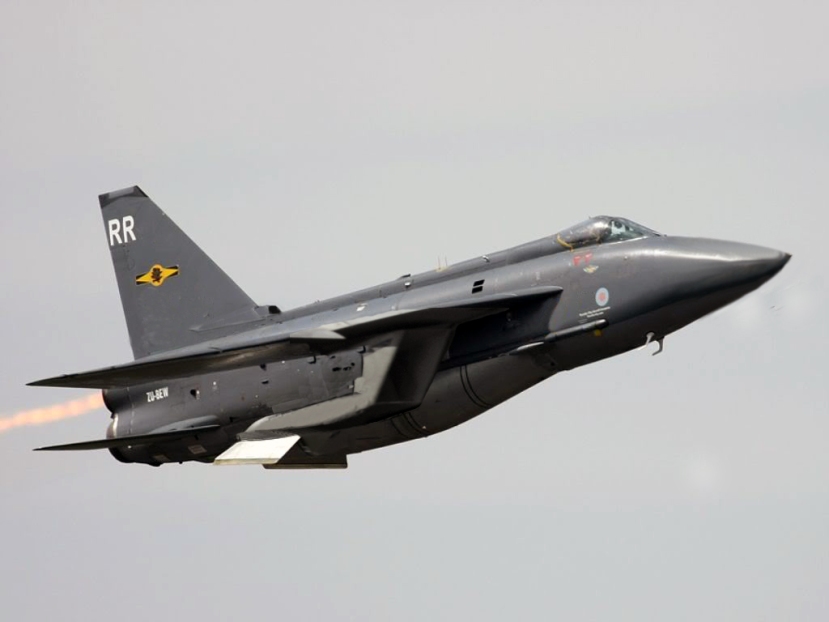The Ultimate What-if: British Aerospace Super Lightning
Following the cancellation of the Tornado ADV, BAe proposed an enhanced Lightning as an interim fighter/interceptor for the RAF until a longer term solution was found. The initial proposal included the replacement of the AI.23 radar with the notional AI.25 based on the Sea Harrier’s Blue Fox, and the integration of AIM-9L Sidewinder and Sky Flash missile capability. Encouraged by trials of the ECL (Enhanced Capability Lightning) test aircraft (XL629), BAe proposed a far more radical upgrade. The greatest limitation of the Lightning was its fuel-thirsty Avon engines, replacing these with modern engines would have two major advantages. Firstly, new engines would be far more efficient and use less fuel, secondly, they would be smaller and create plenty of new internal volume for extra fuel or avionics. By moving the engines air intake location from the nose to below the wings, room was created for a larger radar, and the obvious candidate was the AI.24 Foxhunter that had been conceived for the aborted Tornado ADV. The Turbo Union RB.199 was fitted to the ECL in 1984, but results were discouraging.
General Electric proposed an uprated version of the F404 (the engine used by the F/A-18 Hornet). This engine, named the Wye, was tested on a modified F/A-18 and later on ECL-2 (XR763). Integration of the Wye into ECL-2 proved harder than anticipated, but once fitted the results were remarkably good. The project received a great deal of criticism, with many asking why the project was happening when a modern off the shelf system (such as the F-15) would be cheaper, superior and have a longer service life. But by this time, as the Royal Saudi Air Force was to a large degree funding the project, it grew more and more ambitious (this included a greatly improved wing and ECM suite). The first production aircraft flew from Warton in 1988, and deliveries to the RAF and RSAF began in 1990.
Such was the RAF’s confidence in the type that it deployed a combat evaluation detachment to Saudi Arabia during Operation Granby (Desert Storm). During this operation a lone Super Lightning destroyed two Iraqi air force MiG-21s (one with Sky Flash, and one with AIM-9L).
The 25-mm Aden cannon proved unreliable and were replaced by 27-mm Mausers, giving commonality with the Tornado force.
Like to know about the MiG-37 and Russian stealth? Click here.
Specifications
British Aerospace Super Lightning F.Mk 1
Type: Single-seat fighter/ interceptor
Crew: 1
Length: 55 ft 3 in (16.8 m)
Wingspan: 34 ft 10 in (10.6 m)
Height: 19 ft 7 in (5.97 m)
Wing area: 551 sq ft, 51.2 m²
Empty weight: 31,068 lb (14092 kg)
Max. take-off weight: 61,700 lb (28000 kg)
Powerplant: 2 × General Electric/Rolls-Royce F414-RR545 Wye turbofans,
maximum thrust: 13,000 lbf (62.3 kN) in mil power, 22,000 lbf (97.9 kN) (with reheat)
Performance:
Maximum speed: High altitude: Mach 2.5+ (1,650+ mph, 2665+ km/h)
Low altitude: Mach 1.2 (900 mph, 1450 km/h)
Standard armament: One 25- mm Aden cannon with 140 rounds,
four Sky Flash and two AIM-9L Sidewinder
Find out about the latest Hush-Kit articles on Twitter: @Hush_kit
Who was Sweden’s flying farm girl?


Trouble with using side intakes as shown the Avons werent stacked at the tail end , but with lower engine starting where the intake starts and the upper engine just where the wing flaps start above the wing.
Much more likely was something like the BAC P96 ( an F18 look-a -like , first flight 1983) or the HS 1205, like F16 with twin tails.
Well,Super BAC Lightning….as a british aviation,EJ200 may be more reasonable than F414 I think….
SHADO called. They want their Sky One back. 😉
Haha like it. But RAF should just have bought F15s. That’s the real fantasy